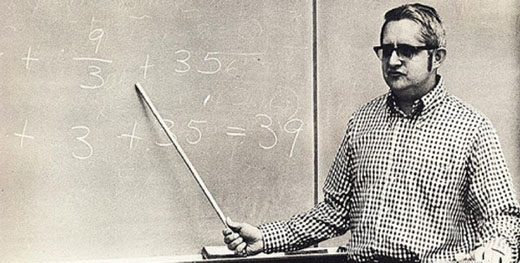Who is to blame for the fact that the site is not fulfilling its functions?
- Transfer
Meet - John, the owner of a fairly large site, a marketer, considers himself smart, professional, and also confident that he can clearly state his thoughts. With all this, John doesn’t know much about web design and development, so he needs your help. John turns to you with a whole set of clear marketing goals and asks you to name the price of his work.
Before you name the price, you ask John about his project. After a couple of minutes of conversation, you ask a question about the budget. In your opinion, this is a fair question. After all, there can be so many approaches to solving the problem. Without knowing the budget, you cannot determine where to start work. You think that creating a site is like building a house - without knowing the budget, you won’t be able to find out how many rooms the client wants and what materials should be used.
John, in turn, is suspicious of your question. Why do you need to know about his budget? The only convincing reason that comes to his mind is that you don’t want to accidentally name the price less than what he is willing to pay. In addition, he himself does not know what his budget is. How does he know how much the site costs?

The client should not think that you are luring money from him.
John is leaving. He is determined to find an honest web developer who is not going to trick him. Luckily for you, all the other developers also don’t explain why they need to know about John’s budget, and in the end, you can even get John back.
Once you have received this project, you are organizing a meeting in order to agree on all the details. However, John immediately regrets his decision to contact you, as his fears were confirmed. He thinks that you want to squeeze out more money from him, telling all sorts of nonsense about the usability or accessibility of the site. John doesn’t give a damn about visitors with disabilities; he doesn’t even think that such people visit his site.
As for usability, of course, a web developer is required to make the site easy to use. Why do we need expensive usability testing? He thinks that such testing involves the use of expensive equipment, such as cameras, laboratories, and double-sided mirrors. You thought you clearly explained all of these issues. You talked about WCAG 2 and even remembered Jacob Nielsen. You begin to suspect that John is slightly taut.

If you want the client to understand you, avoid technical details.
He probably would have listened to you if you talked about the availability of the site, as a method of increasing positions in search engines or increasing profits brought by the site. And so, John rests his feet and refuses to pay for all these "unnecessary additions."
You leave the meeting, happy that you managed to sign a contract. But some premonition indicates to you that this is one of those terrible projects that you had to do. Despite this, you remain optimistic and head deep into the workflow. Almost immediately, you get a call from John. He asks if you are ready to show him something. You explain that it’s too early to show anything, John is disappointed but temporarily leaves you alone.
A little later, you are ready to introduce John to the design. You really like the result, and in spite of the fact that it took a lot more time than it was stipulated in the budget, it is worth it. The final design has a very high usability and will be the gem of your portfolio.

Do not hide from customers. Show them the results of work at the earliest stages and involve them in the development process.
John sees the design and is horrified. In his opinion, you worked in the wrong way. The design contradicts offline marketing materials and does not emphasize the benefits of his company's services. In addition, he is confident that his suppliers will not like the design, and although they are not end users, their opinion is very important.
After a tense conference, your enthusiasm naturally disappeared, but you managed to reach a compromise that may make John happy. You begin to think if it wasn’t better to present your initial ideas and sketches to John.
After much torment and compromise, you are ready to present John with a new layout. John likes the new design a lot more, and he believes that you are moving in the right direction, but something does not suit him. For starters, he doesn't like that in order to see all the content you have to scroll down the window, and there is too much white space on all sides of the layout. He tells you to move the content, and fill in the empty space. John also thinks about the audience of his site, most of which are young men, and believes that the color scheme of the site is too delicate. He asks to add a blue color to it.
While John is almost happy, you feel crushed. It seems to you that he wants to do the work in your place. He constantly asks for something to move somewhere or change color, as if your duty is only to move the pixels.

Enlighten your customers so they can make the right decisions.
At this point, you are confident that the client is a fool and the only thing you want is to quickly flip this design to him. And you are not going to ask John why he needs these changes. Perhaps, understanding his thinking, you could explain what screen resolution is and offer some alternative to the boring blue that the Internet is teeming with.
Instead, you wash your hands and just give John what he wants.
Now that the design is ready, you switch to its layout. John, of course, doesn't care about your code. Finally, you can do it right.
This is a difficult job and it takes a lot of time. Despite the fact that you spent too much time on the design, and, in the end, gave up and did everything as the client wanted, you still have pride. And you are not going to hack things with the code. Be that as it may, other designers can see and criticize your design! You work tirelessly, trying even more than necessary. Along the way, John manages to add a headache to you, slipping additional functional tasks.
John wonders where you went. You haven’t heard anything from you for several weeks now. The site, of course, should be ready by this time.
John writes you an e-mail and asks how the work is going. You answer briefly that work is slow, but true. You never liked project management, and you think that John would like you to spend time working, rather than writing detailed reports.
John gets your answer and is very upset. What does it mean “slowly but surely”? He writes again and asks about the expected completion date, you give an approximate estimate.
The date comes and goes, but nothing is heard from you. This is just a rough estimate, and some complications pushed the date for a couple of days! John goes nuts and calls you. He says that he has already organized an advertising campaign, the beginning of which should coincide with the end of the work. Since there was no news from you, he decided that everything was going according to plan.

Communicate regularly with the client.
You defend yourself by talking about unexpected difficulties. But it becomes difficult to answer when John writes: "All I needed was to be aware of what was happening, just one letter a week!".
At this point, you finally quarreled with the client. You are done and the site is up. John grumbles and pays the bill after a long delay. You are surprised that John expresses his disappointment and dissatisfaction with the result of your work. How so, you did everything that he asked? This guy is not just slow-witted, he is a moron!
Naturally, John looks at everything differently. He came to you with a list of marketing tasks, and the site that you developed does not fulfill any of them. He hoped to launch the site, achieve its goals and embark on a new project. But, after the initial jump in interest in the site, the number of visitors and requests fell, and the site itself stopped working.

Make sure that the client understands what support his project will need in the future.
John does not understand that the site needs constant care and support. You cannot create a site and then abandon it. It needs to be fueled by new content that will interest visitors. In addition, it is important to plan the development of the site in the future.
If someone told him about it ...
It is incredible how quickly we condemn our customers without really understanding. We are web developers, and our job is to convey information and empathize. Our task is to transmit messages from our customers to users of their sites. By creating sites, we put ourselves in the place of their visitors in order to better understand their needs.
Why so often we fail to convey information and empathize with our customers? Perhaps it’s time for us to apply the skills that we have gained while working as web developers in communicating with clients.
-

Always explain to the client why you are asking about the budget.
Before you name the price, you ask John about his project. After a couple of minutes of conversation, you ask a question about the budget. In your opinion, this is a fair question. After all, there can be so many approaches to solving the problem. Without knowing the budget, you cannot determine where to start work. You think that creating a site is like building a house - without knowing the budget, you won’t be able to find out how many rooms the client wants and what materials should be used.
John, in turn, is suspicious of your question. Why do you need to know about his budget? The only convincing reason that comes to his mind is that you don’t want to accidentally name the price less than what he is willing to pay. In addition, he himself does not know what his budget is. How does he know how much the site costs?

The client should not think that you are luring money from him.
John is leaving. He is determined to find an honest web developer who is not going to trick him. Luckily for you, all the other developers also don’t explain why they need to know about John’s budget, and in the end, you can even get John back.
Make all recommendations clear to John
Once you have received this project, you are organizing a meeting in order to agree on all the details. However, John immediately regrets his decision to contact you, as his fears were confirmed. He thinks that you want to squeeze out more money from him, telling all sorts of nonsense about the usability or accessibility of the site. John doesn’t give a damn about visitors with disabilities; he doesn’t even think that such people visit his site.
As for usability, of course, a web developer is required to make the site easy to use. Why do we need expensive usability testing? He thinks that such testing involves the use of expensive equipment, such as cameras, laboratories, and double-sided mirrors. You thought you clearly explained all of these issues. You talked about WCAG 2 and even remembered Jacob Nielsen. You begin to suspect that John is slightly taut.

If you want the client to understand you, avoid technical details.
He probably would have listened to you if you talked about the availability of the site, as a method of increasing positions in search engines or increasing profits brought by the site. And so, John rests his feet and refuses to pay for all these "unnecessary additions."
Get John involved in the workflow
You leave the meeting, happy that you managed to sign a contract. But some premonition indicates to you that this is one of those terrible projects that you had to do. Despite this, you remain optimistic and head deep into the workflow. Almost immediately, you get a call from John. He asks if you are ready to show him something. You explain that it’s too early to show anything, John is disappointed but temporarily leaves you alone.
A little later, you are ready to introduce John to the design. You really like the result, and in spite of the fact that it took a lot more time than it was stipulated in the budget, it is worth it. The final design has a very high usability and will be the gem of your portfolio.

Do not hide from customers. Show them the results of work at the earliest stages and involve them in the development process.
John sees the design and is horrified. In his opinion, you worked in the wrong way. The design contradicts offline marketing materials and does not emphasize the benefits of his company's services. In addition, he is confident that his suppliers will not like the design, and although they are not end users, their opinion is very important.
After a tense conference, your enthusiasm naturally disappeared, but you managed to reach a compromise that may make John happy. You begin to think if it wasn’t better to present your initial ideas and sketches to John.
Tell John about Design
After much torment and compromise, you are ready to present John with a new layout. John likes the new design a lot more, and he believes that you are moving in the right direction, but something does not suit him. For starters, he doesn't like that in order to see all the content you have to scroll down the window, and there is too much white space on all sides of the layout. He tells you to move the content, and fill in the empty space. John also thinks about the audience of his site, most of which are young men, and believes that the color scheme of the site is too delicate. He asks to add a blue color to it.
While John is almost happy, you feel crushed. It seems to you that he wants to do the work in your place. He constantly asks for something to move somewhere or change color, as if your duty is only to move the pixels.

Enlighten your customers so they can make the right decisions.
At this point, you are confident that the client is a fool and the only thing you want is to quickly flip this design to him. And you are not going to ask John why he needs these changes. Perhaps, understanding his thinking, you could explain what screen resolution is and offer some alternative to the boring blue that the Internet is teeming with.
Instead, you wash your hands and just give John what he wants.
Chat with John regularly
Now that the design is ready, you switch to its layout. John, of course, doesn't care about your code. Finally, you can do it right.
This is a difficult job and it takes a lot of time. Despite the fact that you spent too much time on the design, and, in the end, gave up and did everything as the client wanted, you still have pride. And you are not going to hack things with the code. Be that as it may, other designers can see and criticize your design! You work tirelessly, trying even more than necessary. Along the way, John manages to add a headache to you, slipping additional functional tasks.
John wonders where you went. You haven’t heard anything from you for several weeks now. The site, of course, should be ready by this time.
John writes you an e-mail and asks how the work is going. You answer briefly that work is slow, but true. You never liked project management, and you think that John would like you to spend time working, rather than writing detailed reports.
John gets your answer and is very upset. What does it mean “slowly but surely”? He writes again and asks about the expected completion date, you give an approximate estimate.
The date comes and goes, but nothing is heard from you. This is just a rough estimate, and some complications pushed the date for a couple of days! John goes nuts and calls you. He says that he has already organized an advertising campaign, the beginning of which should coincide with the end of the work. Since there was no news from you, he decided that everything was going according to plan.

Communicate regularly with the client.
You defend yourself by talking about unexpected difficulties. But it becomes difficult to answer when John writes: "All I needed was to be aware of what was happening, just one letter a week!".
Explain to John his role in the further development of the project.
At this point, you finally quarreled with the client. You are done and the site is up. John grumbles and pays the bill after a long delay. You are surprised that John expresses his disappointment and dissatisfaction with the result of your work. How so, you did everything that he asked? This guy is not just slow-witted, he is a moron!
Naturally, John looks at everything differently. He came to you with a list of marketing tasks, and the site that you developed does not fulfill any of them. He hoped to launch the site, achieve its goals and embark on a new project. But, after the initial jump in interest in the site, the number of visitors and requests fell, and the site itself stopped working.

Make sure that the client understands what support his project will need in the future.
John does not understand that the site needs constant care and support. You cannot create a site and then abandon it. It needs to be fueled by new content that will interest visitors. In addition, it is important to plan the development of the site in the future.
If someone told him about it ...
Moral of history
It is incredible how quickly we condemn our customers without really understanding. We are web developers, and our job is to convey information and empathize. Our task is to transmit messages from our customers to users of their sites. By creating sites, we put ourselves in the place of their visitors in order to better understand their needs.
Why so often we fail to convey information and empathize with our customers? Perhaps it’s time for us to apply the skills that we have gained while working as web developers in communicating with clients.
-

